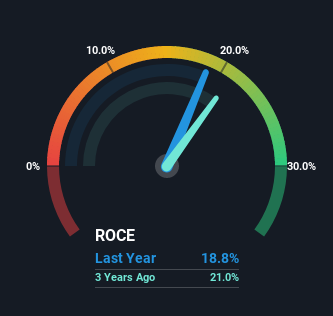Returns On Capital At Sage Group (LON:SGE) Have Stalled
What are the early trends we should look for to identify a stock that could multiply in value over the long term? Firstly, we'd want to identify a growing return on capital employed (ROCE) and then alongside that, an ever-increasing base of capital employed. This shows us that it's a compounding machine, able to continually reinvest its earnings back into the business and generate higher returns. So, when we ran our eye over Sage Group's (LON:SGE) trend of ROCE, we liked what we saw.
Return On Capital Employed (ROCE): What Is It?
For those who don't know, ROCE is a measure of a company's yearly pre-tax profit (its return), relative to the capital employed in the business. Analysts use this formula to calculate it for Sage Group:
Return on Capital Employed = Earnings Before Interest and Tax (EBIT) ÷ (Total Assets - Current Liabilities)
0.19 = UK£454m ÷ (UK£3.5b - UK£1.1b) (Based on the trailing twelve months to March 2022).
Therefore, Sage Group has an ROCE of 19%. On its own, that's a standard return, however it's much better than the 7.9% generated by the Software industry.
See our latest analysis for Sage Group
In the above chart we have measured Sage Group's prior ROCE against its prior performance, but the future is arguably more important. If you're interested, you can view the analysts predictions in our free report on analyst forecasts for the company.
What Does the ROCE Trend For Sage Group Tell Us?
While the current returns on capital are decent, they haven't changed much. The company has consistently earned 19% for the last five years, and the capital employed within the business has risen 31% in that time. 19% is a pretty standard return, and it provides some comfort knowing that Sage Group has consistently earned this amount. Over long periods of time, returns like these might not be too exciting, but with consistency they can pay off in terms of share price returns.
The Bottom Line On Sage Group's ROCE
To sum it up, Sage Group has simply been reinvesting capital steadily, at those decent rates of return. In light of this, the stock has only gained 6.3% over the last five years for shareholders who have owned the stock in this period. So to determine if Sage Group is a multi-bagger going forward, we'd suggest digging deeper into the company's other fundamentals.
On a final note, we've found 1 warning sign for Sage Group that we think you should be aware of.
While Sage Group may not currently earn the highest returns, we've compiled a list of companies that currently earn more than 25% return on equity. Check out this free list here.
Have feedback on this article? Concerned about the content? Get in touch with us directly. Alternatively, email editorial-team (at) simplywallst.com.
This article by Simply Wall St is general in nature. We provide commentary based on historical data and analyst forecasts only using an unbiased methodology and our articles are not intended to be financial advice. It does not constitute a recommendation to buy or sell any stock, and does not take account of your objectives, or your financial situation. We aim to bring you long-term focused analysis driven by fundamental data. Note that our analysis may not factor in the latest price-sensitive company announcements or qualitative material. Simply Wall St has no position in any stocks mentioned.
Join A Paid User Research Session
You’ll receive a US$30 Amazon Gift card for 1 hour of your time while helping us build better investing tools for the individual investors like yourself. Sign up here

